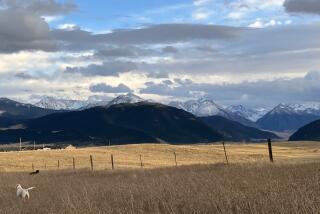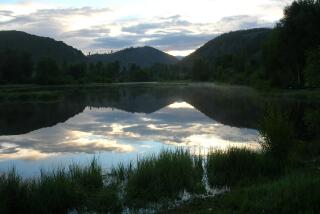Echo of a Simpler Time : Modern ‘Mountain Men’ Flock to Weekend Rendezvous, Rituals
- Share via
GREELEY, Colo. — They have a heavy-duty look, with muskets slung over their shoulders, full beards, knives in their belts, a competitive glint in their eyes. Their wives sew.
They call themselves mountain men--after the likes of Jim Bridger, Joe Meeks, William Sublette, Jim Beckwourth--men who wrestled grizzlies and lived Indian style before the mountains came under the protection of the Stars and Stripes and the U.S. Cavalry.
They’re out there now, shades of the early 1800s, every weekend, thousands of them, a reborn subculture that one scholar says may rival the rodeo in popularity.
They meet in something called a rendezvous. It is an encampment of tepees, lodges and tents, although why it is called by a French term is somewhat unclear.
Patrick McCarthy, an assistant professor of film and television at the University of Northern Colorado here, estimates that perhaps 250,000 people have attended rendezvous across the United States, dressed as 19th-Century trappers and traders.
Perhaps 3 million people, he said, have been guests at a rendezvous. Their popularity has blossomed coast to coast, with as many as 30 rendezvous a year held in Colorado alone.
“Every indication I have is that the mountain man subculture is growing,” McCarthy said. “It hasn’t reached its peak yet.”
Maybe it’s the appeal of the wilderness and the simplicity of the life style, or maybe it’s a subconscious yearning for the days when men were men and got away with it. Whatever it is, there they are, facing nature in the 20th Century clad in skins or other quaint garments of wool, cotton or linen.
The rendezvous often is also a bazaar where fire-starting kits, knives, guns and clothing can be bought or bartered for. Blacksmiths work at crude forges to craft blades, candlestick holders and cookware.
And there is a competitive edge--shooting matches, knife and tomahawk-throwing contests. At day’s end there is the ceremonial campfire and a group meal.
Ritual Handshake-Hug
They use a ritualistic greeting, usually a handshake followed by a thumbshake, and that is usually followed by a hug, called a squoze. Which is then followed by the question, “Did you winter well?”
At rendezvous in the Old West, trappers gathered to replenish supplies, sip whiskey hauled from the East and send their year’s harvest of pelts back to civilization, where beaver was in great demand for gentlemen’s top hats.
McCarthy, whose dark, shoulder-length hair and heavy beard show hints of gray, says he moved here a year ago because “Colorado geographically is the center of the mountain man subculture. I’m here primarily because of my research interest.”
McCarthy’s doctoral dissertation concerned the mountain man subculture, and he has published several articles on the subject. This summer he is teaching a journalism workshop called “Mountain Man Subculture.”
He says the 19th-Century mountain man was “a mercantile capitalist who lived a scavenger life style. His halcyon years were from 1825 to 1840. That was when the mountain man was at his peak of activity.”
He lived off a raw and hostile land sparsely populated by nomadic tribes. His tools were traps, knives and rifles. His rugged life has been the subject of 40 or more movies.
The reborn mountain man subculture began flourishing in the 1970s, and some of the interest was sparked by the U.S. bicentennial, McCarthy says.
He calls it “a weapons-minded subculture.” There are displays of guns and knives. “Competition is built around the weapons. Shooting a gun is an act of dominance,” he says.
A modern mountain man may invest $1,000 or more in his weaponry, clothing and rendezvous living quarters.
McCarthy attends rendezvous as an interested but detached observer, and he has interviewed some of the mountain men.
One of his first questions is: “Why are you here?”
“Almost invariably,” he says, “the answer is ‘Camaraderie.’ ”
“One way to put off the future is to retreat to the past,” McCarthy says. “Maybe it’s a regressive activity. We’re not ready to step into the 21st Century.
“What does the mountain man represent? Democratic ideals of individuality and freedom. No one was more free and individualistic,” McCarthy says.
Ron Melchert, a retired Army officer who operates a gunsmith shop in Penrose, Colo., is a modern-day mountain man whose rendezvous nickname is Blind Squirrel.
He started as a shooting competitor.
“I like (dressing up and organized shoots) because it is family-oriented,” Melchert said. “The kids are included.”
“People come for different reasons,” McCarthy says. “They may come to shoot, trade or just picnic on a Saturday afternoon.
“Some are more serious mountain men. They feel they are the most authentic.”
Rendezvous vary in size from the crowd of about 30,000 people who meet annually at Ft. Bridger, Wyo., to gatherings of only a few.
Two other large events are the Green River Rendezvous in Pinedale, Wyo., and the Rocky Mountain Men Rendezvous in Jefferson, Colo.
They are organized by a wide range of groups and individuals, ranging from the National Muzzle-Loading Rifle Assn. to ranchers.
The outings produce some incongruities--such as the Lincoln Continental parked next to a tepee at Lost Park, Colo.
But for the most part, the mountain men insulate themselves from the outside world. As one told his wife when she said she was going into town to buy a newspaper:
“I don’t need no newspaper. I’m at the rendezvous.”
More to Read
Sign up for The Wild
We’ll help you find the best places to hike, bike and run, as well as the perfect silent spots for meditation and yoga.
You may occasionally receive promotional content from the Los Angeles Times.






